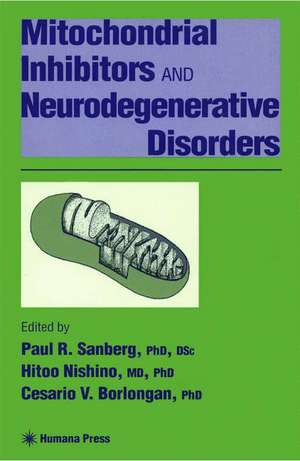Mitochondrial Inhibitors and Neurodegenerative Disorders: Contemporary Neuroscience
Editat de Paul R. Sanberg, Hitoo Nishino, Cesario V. Borlonganen Limba Engleză Hardback – oct 1999
| Toate formatele și edițiile | Preț | Express |
|---|---|---|
| Paperback (1) | 945.47 lei 43-57 zile | |
| Humana Press Inc. – 27 iul 2012 | 945.47 lei 43-57 zile | |
| Hardback (1) | 952.40 lei 43-57 zile | |
| Humana Press Inc. – oct 1999 | 952.40 lei 43-57 zile |
Din seria Contemporary Neuroscience
- 5%
 Preț: 1128.63 lei
Preț: 1128.63 lei - 18%
 Preț: 965.52 lei
Preț: 965.52 lei - 5%
 Preț: 1108.35 lei
Preț: 1108.35 lei - 18%
 Preț: 1228.15 lei
Preț: 1228.15 lei - 18%
 Preț: 1229.73 lei
Preț: 1229.73 lei - 18%
 Preț: 1231.64 lei
Preț: 1231.64 lei - 18%
 Preț: 945.47 lei
Preț: 945.47 lei - 18%
 Preț: 1244.08 lei
Preț: 1244.08 lei - 15%
 Preț: 638.76 lei
Preț: 638.76 lei - 18%
 Preț: 1240.47 lei
Preț: 1240.47 lei - 18%
 Preț: 1385.99 lei
Preț: 1385.99 lei - 18%
 Preț: 1227.84 lei
Preț: 1227.84 lei - 18%
 Preț: 1220.88 lei
Preț: 1220.88 lei - 18%
 Preț: 961.55 lei
Preț: 961.55 lei - 15%
 Preț: 695.70 lei
Preț: 695.70 lei - 18%
 Preț: 959.82 lei
Preț: 959.82 lei - 5%
 Preț: 1112.17 lei
Preț: 1112.17 lei - 18%
 Preț: 1233.83 lei
Preț: 1233.83 lei - 18%
 Preț: 950.96 lei
Preț: 950.96 lei - 24%
 Preț: 799.49 lei
Preț: 799.49 lei - 18%
 Preț: 954.77 lei
Preț: 954.77 lei - 18%
 Preț: 1227.21 lei
Preț: 1227.21 lei - 5%
 Preț: 1117.46 lei
Preț: 1117.46 lei - 18%
 Preț: 1248.02 lei
Preț: 1248.02 lei - 18%
 Preț: 949.10 lei
Preț: 949.10 lei - 5%
 Preț: 1114.35 lei
Preț: 1114.35 lei - 15%
 Preț: 694.22 lei
Preț: 694.22 lei - 18%
 Preț: 950.52 lei
Preț: 950.52 lei - 5%
 Preț: 1124.07 lei
Preț: 1124.07 lei - 5%
 Preț: 1117.10 lei
Preț: 1117.10 lei - 24%
 Preț: 1089.43 lei
Preț: 1089.43 lei - 18%
 Preț: 1227.52 lei
Preț: 1227.52 lei - 18%
 Preț: 955.08 lei
Preț: 955.08 lei - 5%
 Preț: 1417.38 lei
Preț: 1417.38 lei
Preț: 952.40 lei
Preț vechi: 1161.47 lei
-18% Nou
Puncte Express: 1429
Preț estimativ în valută:
182.24€ • 190.78$ • 150.79£
182.24€ • 190.78$ • 150.79£
Carte tipărită la comandă
Livrare economică 07-21 aprilie
Preluare comenzi: 021 569.72.76
Specificații
ISBN-13: 9780896038059
ISBN-10: 089603805X
Pagini: 314
Ilustrații: XVIII, 314 p. 81 illus.
Dimensiuni: 155 x 235 x 19 mm
Greutate: 0.64 kg
Ediția:2000
Editura: Humana Press Inc.
Colecția Humana
Seria Contemporary Neuroscience
Locul publicării:Totowa, NJ, United States
ISBN-10: 089603805X
Pagini: 314
Ilustrații: XVIII, 314 p. 81 illus.
Dimensiuni: 155 x 235 x 19 mm
Greutate: 0.64 kg
Ediția:2000
Editura: Humana Press Inc.
Colecția Humana
Seria Contemporary Neuroscience
Locul publicării:Totowa, NJ, United States
Public țintă
ResearchCuprins
I. Mitochondrial Toxins: Symptomatology, Origin, and Chemistry.- 1 • Clinical Manifestations and Mechanisms of Action of Environmental Mitochondrial Toxins.- 2 • History of 3-Nitropropionic Acid: Occurrence and Role in Human and Animal Disease.- 3 • The Neurochemistry of 3-Nitropropionic Acid.- II. Mitochondrial Dysfunctions: Models of Neurodegeneration and Mechanisms of Action.- 4 • In Vitro Studies of 3-Nitropropionic Acid.- 5 • Cognitive and Motor Deficits Produced by Acute and Chronic Administration of 3-Nitropropionic Acid in Rats.- 6 • Comparative Study on 3-Nitropropionic Acid Neurotoxicity.- 7 • Mechanisms of 3-Nitropropionic Acid Neurotoxicity.- 8 • Gender-Related Difference of the Effect of 3-Nitropropionic Acid on Striatal Artery.- 9 • Variable Susceptibility to Neurotoxicity of Systemic 3-Nitropropionic Acid.- 10 • The 3-Nitropropionic Acid Model of Huntington’s Disease: Do Alterations in the Expression of Metabolic mRNAs Predict the Development of Striatal Pathology?.- 11 • Mechanisms of Action of 3-Nitropropionic Acid: Dopamine Overflow and Vulnerability of the Lateral Striatal Artery.- 12 • Mitochondrial Inhibition and Neuronal Death in Huntington’s Disease.- 13 • Effects of Brain Mitochondrial Metabolism, Aging, and Caloric Restriction on Membrance Lipids and Proteins: An Electron Paramagnetic Resonance Investigation.- 14 • Malonate: Profile and Mechanisms of Striatal Toxicity.- 15 • Malonic Acid and the Chronic Administration Model of Excitotoxicity.- 16 • Sodium Azide-Induced Neurotoxicity.- III. Treatment Interventions for Mitochondrial-Induced Neurotoxicity.- 17 • Neuroprotective Strategies Against Cellular Hypoxia.- 18 • Neuroprotective Effect of Perinatal Hypoxia Against 3-Nitropropionic Acid Neurotoxicity.-19 • Neural Transplantation and Huntington’s Disease: What Can We Learn from the 3-Nitropropionic Acid Model?.- 20 • Neuroprotective Strategies in Parkinson’s Disease and Huntington’s Chorea: MPTP- and 3-NPA-Induced Neurodegeneration as Models.
Recenzii
"...is a concise summary of the present state of research in the area of mitochondrial toxins and their role in animal models of neurodegenerative disease."-J Neuropsychiatry Clin Neurosci
Textul de pe ultima copertă
In Mitochondrial Inhibitors and Neurodegenerative Disorders, respected investigators from around the world critically review what is known about the role of mitochondrial inhibitors in cell death and the onset of neurodegeneration. These distinguished researchers-many pioneers in the field-detail the symptomatology, origin, and chemistry of mitochondrial toxins, and discuss animal models of human diseases related to abnormal mitochondrial function. The book focuses on 3-nitropropionic acid (3-NP) and its ability to replicate the cellular, anatomical, and behavioral alterations seen in Huntington's disease, and demonstrates that mitochondrial inhibitors play an important role in the etiology of central nervous system disorders. In addition, recent therapeutic modalities aimed at rescuing the central nervous system from abnormal functioning by mitochondria are discussed.
With its timely, in-depth review, Mitochondrial Inhibitors and Neurodegenerative Disorders offers today's advanced investigators powerful insights into how mitochondrial toxins precipitate and exacerbate neurodegenerative disorders, and details important new treatment strategies that can halt or reverse disease progression.
With its timely, in-depth review, Mitochondrial Inhibitors and Neurodegenerative Disorders offers today's advanced investigators powerful insights into how mitochondrial toxins precipitate and exacerbate neurodegenerative disorders, and details important new treatment strategies that can halt or reverse disease progression.
















